I want to share how to prepare the slurpingly delicious Taiwanese beef noodle soup.
This Taiwanese beef noodle soup is my go-to comfort food that makes my tummy rumble with its umami-rich soup base and melts in the mouth tender beef. The hunger-inducing aroma is the result of the intermingling of a variety of Asian spices, aromatics, and herbs. So it is hard to resist when the remarkable aroma wafts up along with the steam from the bowl. It is a noodles dish that the whole family will enjoy.
Taiwanese beef noodle soup 红烧牛肉面 is a popular staple in different countries in Asia. This Asian beef noodle soup is similar to the Szechuan-style beef noodles soup, except it is not spicy.
In this article, I will cook how it is served in Malaysia, where I live. It might be slightly different from the traditional version from Taiwan. However, I will stay true to the authentic flavor by adding the Szechuan chili bean sauce as the primary flavoring ingredient.
I will explain every step essential to produce a bowl of umami-rich noodle soup, rather than drilling into the regional difference of the flavor.
Let’s kick off by preparing the beef soup.
Note: This post may contain affiliate links. Please read my privacy policy for more info. I may receive commissions for purchases made through links in this post.

1. Blanch the beef
You can use almost any cuts of beef, such as beef shank, brisket, beef tendon, and chuck. These cuts are tougher and have more fats than sirloin, but they are perfect for braising for a few hours, turning into tender beef.
You can shorten the time of braising with the pressure cooker or put it in a slow cooker overnight. The method is similar except adjusting the temperature and time accordingly. I use the ordinary stovetop for cooking this beef noodle soup to illustrate every step.
- Cut the beef across the grain into about 1.5 inches cubes. You may also purchase precut beef chunks from the supermarket to save time.
- Prepare a pot of water with a few pieces of ginger and a handful of scallion that are cut into 5cm sections.
- Add the beef and bring it to a constant boil to blanch for five minutes. Blanching will mainly only cook the surface of the beef, which will not cause any loss of flavor. You will notice that the internal of the piece of meat is still cold and raw after cutting it into chunks. The impurities and blood on the surface will separate from the beef and float on top of the water as scum.
- Discard the whole pot of water and the scum. Wash the beef with cold water or under running water to remove all the impurities.
- Drain the beef in a colander and is now ready to use.
2. Browning the beef
The next step is to brown the beef before braising. Some recipes omit this step, but I prefer browsing it as it creates another dimension of flavor that can only produce by frying it over higher heat. However, you should not overlook this step if your goal is to make a good-quality beef noodles soup.
- Bring the cooking oil to medium-high heat in a well-seasoned wok. You may use a large pan if you prefer. Put the well-drained beef into the hot wok and shear both sides of the beef until brown.
- The beef will take a longer time to get brown, and oil will splatter if it is wet. Therefore I always make sure the beef is well-drained and dry before browning.
- The beef will exude its juice during browning, which will wet the pan. If this reduces the browning effect, pour the beef along with the juice through a wire mesh strainer to remove it and return the dry beef chunks to the pan. Keep the juice aside and add to the braising liquid in the following step.
- Arrange the beef in a single layer to maximize the contact with the hot surface to get excellent browning. Turn over the meat after a few minutes to brown the other side. You will start to smell the marvelous aroma rising from the pan. Keep it at low to medium heat and be patient. We want to brown the beef as much as possible but not burn it.
- Once the beef is adequately browned, remove the meat from the pan. There should not be any charring if the heat is low during the process.
- Add some hot water to deglaze the pan. Keep the liquid for braising as it contains lots of flavors.
3. Saute the aromatics and spices
- Saute some ginger slices, garlic cloves and white section of the scallion (spring onion) in the pan with some oil. When it becomes aromatic, add a medium-size onion that has been cut into large chunks.
- Add the spices once the onion turns soft and translucent. The spices are cinnamon stick, bay leaves, star anise, dried orange peel, and dried chilies. You can also add some Sichuan peppercorns or black pepper to give it an extra kick.
- Season with brown sugar, Shaoxing wine, light soy sauce, dark soy sauce, salt, chili bean paste, tomato paste.
The chili bean paste and tomato paste add a gorgeous hue to the beef. You should start to smell the fantastic aroma due to the intermingling of flavors of the spices and seasoning.
Note:
- Dried chilies. Omit it if you can not take too spicy food. You can also add fresh red chili, but dried chili is spicier. (Caution: Dried chilies are very spicy!)
- Dried orange peel. This item is called chenpi 陈皮 in Chinese. Dried orange peel is commonly used in Chinese cooking as a dried spice for beef and other stews.
- Brown sugar. Brown sugar adds some caramelized flavor. You can use white sugar for this recipe. Some Chinese prefer rock sugar, which purportedly gives a smoother mouthfeel, although it is not significant.
- Tomato paste. We use tomato paste to provide a reddish hue to the stew, as well as adding some flavor. You can substitute it with ketchup.
- Doubanjiang (Szechuan chili bean paste). This sauce is a unique ingredient that does not have any substitute. It is made with broad bean paste which is one of the main seasonings for Szechuan cuisine. The beef stew will still taste incredible without it, but it will not have the characteristic flavor of the original formula. Since this spicy bean paste contains salt, you need to increase the amount of light soy sauce or add some salt if you want to leave it out.
Note: Dried chiles, dried orange peel, and doubanjiang are available at most Asian markets.
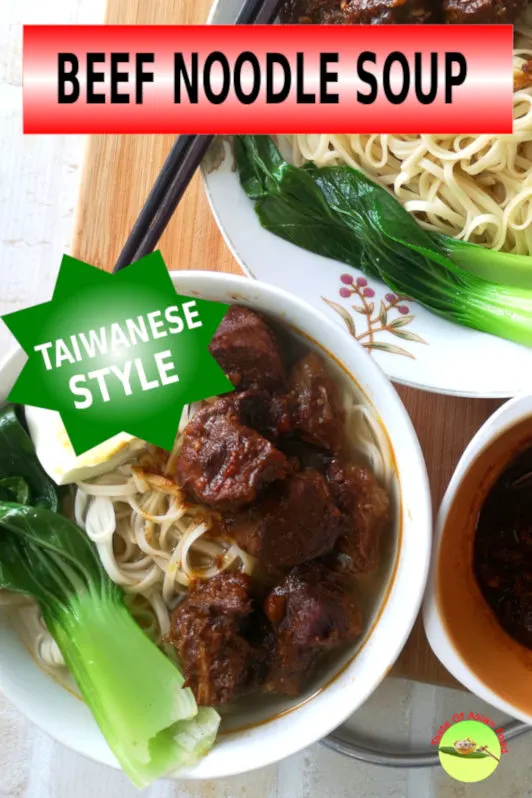
4. Simmer until the beef is tender and soft
You may want to transfer the beef to a smaller pot with a lid to braise it instead of using the pan. Since the pan has a relatively large bottom, more water is required to submerge all the beef to cook evenly.
I transfer it to a small clay pot to braise slowly for three hours! Then, add enough water to cover the beef and reduce to a low simmer. It is passive cooking, but you may want to stir it occasionally and check the water level. Add some water if the braising liquid starts to dry out. Boiling water is preferred as it helps to maintain the temperature at a constant boil at all times.
It will take about two to three hours of braising until the beef is soft and tender with a clay pot or a large Dutch oven. However, you may only need less than an hour by using an instant pot or overnight cooking if you put it into a slow cooker.
The actual duration depends on the cut of meat and the beef chunks’ size. The gold standard is the beef cubes should be able to break it up quickly with the tines of the fork.
Do a taste test before turning off the stove. You can add some rice wine now to accentuate the flavor. I would suggest adjusting it towards the savory and saltier side as the beef and its delicious broth are served along with plain noodles.
5. To serve as a soup or dried noodles
There are two ways to serve braised beef with noodles.
Soup noodles
Prepare a basic soup stock for the noodles. If you have time, get some beef bones to make a pot of beef stock. Season the stock with salt and pepper and pour onto the bowl of egg noodles. Then spoon the beef stew meat along with the gravy on top of the noodles. You may like to make a change with other types of rice noodles.
If you think this is too troublesome, use the supermarket’s ready-made beef broth or chicken stock. Alternatively, use water with some salt to dilute the thick, concentrated braised gravy to make the soup, which will not be as flavorful.
Dried noodles
Alternatively, serve the beef with fresh noodles without the soup.
Place the blanched noodles on a plate, and then mix with some oyster sauce, light soy sauce, sesame oil, and ground white pepper. I have a video to explain how to prepare this dried noodle (Chinese lo mien) in detail. You can follow this link to watch the details.
You can also cook a hard-boiled egg to serve along with the noodles. Garnish with some blanched vegetables such as bok choy, and serve.
Prepare the noodles
You can use any noodles for this Taiwanese beef noodle soup recipe, but I choose the Shanghai ramen. It would be best to blanch the noodles in boiling water until they become al dente. The timing depends on the types of noodles and pleases following the instruction as stated on the packaging.
Drain the noodles in the colander and place them in a bowl. Add the stock and then spoon the beef and the rich beef gravy. Since the beef gravy is highly concentrated, make sure you taste to avoid adding too much, which will turn too salty.
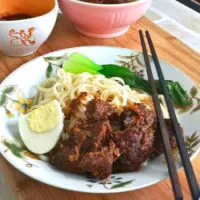
Taiwanese Beef Noodle Recipe
Taiwanese beef noodle soup 红烧牛肉面 is a popular staple in different countries in Asia. This Asian beef noodle soup is very similar to the Szechuan style beef noodles soup.
Ingredients
- 1 kg beef (brisket, chuck)
- To blanch the beef:
- 4 slices ginger
- 1 handful of scallion
- To brown the beef:
- 1.5 tbsp cooking oil
- 4 slices ginger
- 4 cloves garlic, crushed
- 1 handful scallion (cut into sections)
- 1 medium-size onion (cut into large pieces)
- To braise the beef:
- 1 cinnamon bark (about 5cm)
- 2 bay leaves
- 1 star anise (about 10 star-points)
- 1pc large dried orange peel
- 2-4 dried chilies
- 1 tbsp brown sugar
- 2 tbsp Shaoxing wine
- 2.5 tbsp light soy sauce
- 1 tsp dark soy sauce
- 1 tsp salt
- 1.5 tbsp doubanjiang (chili bean paste)
- 1 tbsp tomato paste
- Sufficient water to braise the beef
- Serve with:
- Any noodle of your choice
- Bok choy
- Hard-boiled egg
Instructions
Blanch the beef
Prepare a pot of water with a few pieces of ginger and a handful of scallion that cut into 5cm sections.
Add the beef and bring it to a constant boil to blanch for five minutes.
Wash the beef with cold water briefly to remove all the impurities.
Cut the beef into 1.5 inches pieces.
Drain the beef in a colander and is now ready to use.
Browning the beef
Brown the beef in a pan with some oil until brown on both sides. Remove.
Add some hot water to the pan and deglaze the pan. Keep the liquid to braise to beef.
Saute the aromatics and spices
Saute some ginger slices, garlic cloves and white section of the scallion in the pan with some oil. When it becomes aromatic, add a medium-size onion that has cut into large chunks.
Add the spices once the onion turns soft and translucent. The spices are cinnamon bark, bay leaves, star anise, dried orange peel, and dried chilies.
Season with brown sugar, Shaoxing wine, light soy sauce, dark soy sauce, salt, chili bean paste, tomato paste.
Simmer and serve
Transfer the beef to a smaller pot.
Add sufficient water (and the deglazed liquid) to cover the beef and start to simmer over low heat for 3 hours.
Do a taste test, season with salt.
Serve with any types of noodles, wither with a soup stock or as dried noodles.
Recommended Products
As an Amazon Associate and member of other affiliate programs, I earn from qualifying purchases.
-
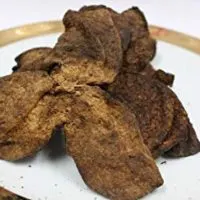 Chinese Cuisine Dried Aged Orange / Citrus Peel / Chen Pi 老年陳皮 Free Worldwide AIR Mail (100G)
Chinese Cuisine Dried Aged Orange / Citrus Peel / Chen Pi 老年陳皮 Free Worldwide AIR Mail (100G) -
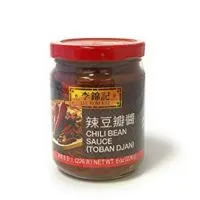 LKK Chili Bean Sauce 8 Oz
LKK Chili Bean Sauce 8 Oz -
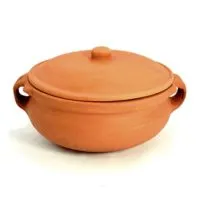 Ancient Cookware Clay Curry Pot, Medium, 8 Inch
Ancient Cookware Clay Curry Pot, Medium, 8 Inch -
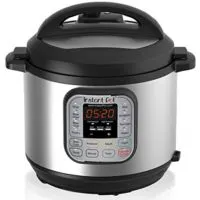 Instant Pot DUO60 6 Qt 7-in-1 Multi-Use Programmable Pressure Cooker, Slow Cooker, Rice Cooker, Steamer, Sauté, Yogurt Maker and Warmer
Instant Pot DUO60 6 Qt 7-in-1 Multi-Use Programmable Pressure Cooker, Slow Cooker, Rice Cooker, Steamer, Sauté, Yogurt Maker and Warmer
Nutrition Information:
Yield: 4 Serving Size: 1Amount Per Serving: Calories: 1071Total Fat: 63gSaturated Fat: 22gTrans Fat: 0gUnsaturated Fat: 32gCholesterol: 283mgSodium: 1959mgCarbohydrates: 43gFiber: 6gSugar: 10gProtein: 81g
This data was provided and calculated by Nutritionix on 7/13/2019

Yi Mein (yee mee / 伊面) - Cantonese noodles recipe - Taste Of Asian Food
Tuesday 24th of September 2024
[…] Taiwanese Beef Noodle Soup (红烧牛肉面) […]
mentari
Sunday 5th of March 2023
lovely recipe, I shall be trying very soon. thank you !
Lynn
Saturday 21st of August 2021
Thank you for providing pictures and correct spelling and the pronunciation of the different products and cuts of meat in your posts, this is most helpful! I enjoy shopping many Asian markets somewhat local to my area, i do have to go about ten miles out to get to them however the reward is a bowl of soup so fragrant and delicious = well worth the trips and so fun! Thank you again your very entertaining and informative to watch! Well done you!
KP Kwan
Saturday 21st of August 2021
It is my pleasure to share, and glad that you love the noodles.
cwgan
Monday 15th of July 2019
is instant pot sold in malaysia with local voltage? I have always wanted to get one. Thanks.
KP Kwan
Tuesday 16th of July 2019
Hi, I know that all the electrical appliances in Malaysia are with the local voltage :) KP Kwan
KP Kwan
Saturday 13th of July 2019
Hi, this is KP Kwan. I am happy to see you in this comment area, as you have read through my recipe. I am pleased to reply to any questions and comments as soon as possible.